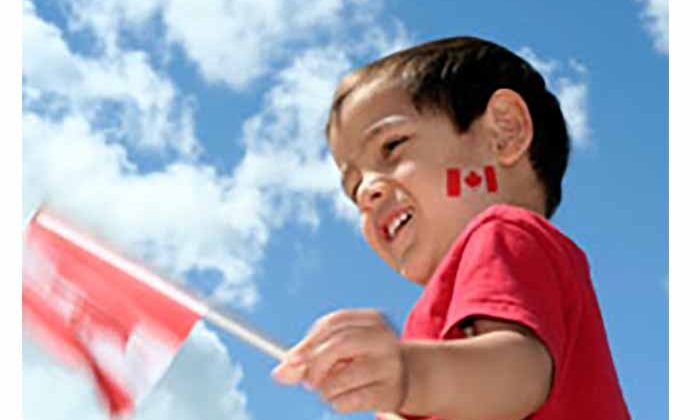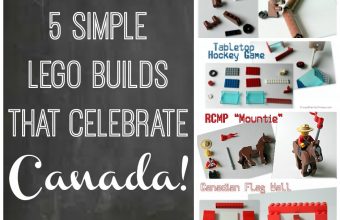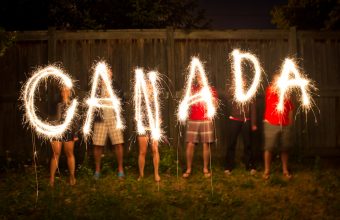When it comes to patriotic party games, it’s easy to add a little Canadian twist to the classics. For the older kids, add some educational elements to the mix, making for a party that’s more than just play—it’s learning, too (but don’t tell them that).
Red Light, White Light
Best for: Ages 1 to 3
A twist on the classic game ‘Red Light, Green Light’ with a little added ‘Grandmother’s Footsteps’, this is a fun Canada Day-themed game that can be adjusted to older kids as well.
You’ll Need:
- A piece of red construction paper (or poster board)
- A piece of white construction paper (or poster board)
- Mini Canadian flags (one per child)
- Two wooden dowels (optional)
How to Play:
- If you choose, turn your red and white paper into octagon-shaped signs that also read STOP (red) and GO, and tape the dowel to the back—this makes it easier for the game leader to hold up the paper.
- Designate a leader for the game (adults or older kids if you’re playing with toddlers).
- Have the toddlers line up on one end of the yard in a horizontal straight line as though waiting to race. If you like, pair them up with an older child or adult.
- The leader then alternates spontaneously between holding up the red STOP sign and the white GO sign.
- When the GO sign is up, they need to offer instructions on how to move forward, such as “walk backwards, hop like a bunny, flap your arms like a bird, take one big step” etc. If you’d like to add even more of a Canadian flavour, have the instructions include Canadian animals—waddle like a Canada Goose, make moose antlers with your hands, stomp like a Grizzly bear, etc.
- If a child moves when the STOP sign is showing, the child must go back to the start line and begin again.
- When they finish, give each child a little Canadian flag to wave as a prize.
 Provincial Relay
Provincial Relay
Best for: Ages 3 to 5
This is a great way to learn Canadian geography and our provinces.
You’ll Need:
- Small recipe cards
- Items appropriate to the decided upon activities
- String (or hula hoops) to differentiate different provincial areas
How to Play:
- Create a fun group activity for each province and territory using something appropriate to the culture. For example, in Ontario, the bird is the Common Loon, so the activity could be “Work as a group to create the most convincing loon sounds”—or the mineral of Manitoba is nickel, so put a bunch of nickels in the jar and have the group guess how many are inside. Look to this site for provincial inspiration.
- Write instructions on each card for each activity, then on the back make sure to write the name of the province/territory.
- Set up 13 areas in a larger outdoor (or indoor) space and put a card in each.
- Divide your guests into teams—consider mixing adults with kids if the kids are on the younger end of the spectrum. You can also do this as one large group activity
- Designate one adult as the judge. This person has access to all the necessary answers to any trivia, and also gets to make decisions on whether or not the group has adequately performed the desired activity.
- Once each team has gone through each provincial/territorial activity, ask a final Canadian trivia question to end the game. You can reward everyone with one of these delicious desserts [link to one of Jann’s desserts]!
Capture the Flag
Best for: Ages 5 and up
A classic game of Capture the Flag works perfectly for Canada Day—you can use two different provincial flags, one per team, or you can have a little friendly patriotic competition and use a Canadian flag and one from another country.
You’ll Need:
- Two flags
- A large space to run around—park or backyard works best
- Two different sets of coloured bandanas, one per person or strips of fabric in two colours (optional)
- Two hula hoops (optional)
- String (optional)
How to Play:
- Divide your group into two teams.
- Assign a flag (and a colour if you’re using bandanas or fabric) to team A and B.
- Divide the playing field in half and assign one half to each team. Create a border line in the middle (using the string, or natural markings).
- Each team then needs to ‘hide’ their flag, or place their flag inside the hula hoop or a string circle in an area far from the ‘border line’ in the middle. That is the ‘safe’ area for members of the opposing team.
- The goal is for some members of team A and B to infiltrate the opposite side, steal the flag of the opposite team, and return it safely to their own side. The first team to do this wins!
Rules:
- Players cannot enter their own team’s safe area. They can only patrol around the outside of it.
- Only a limited number of players are allowed to guard the safe area (1 to 3) to allow the opposite team the chance to actually enter and ‘capture’ the flag.
- On each team, the players have three roles: some run to the opposing team’s side to try and capture the flag; some stay on their own side to tag players from the opposing team invading their area; a few guard the safe area.
- If you are ‘tagged’ while in the opposite area, you can either be taken to a designated ‘jail’ area, or remain frozen. The only way to be set free is to be tagged by a member of your own team.
- If you choose to have a ‘jail’ area, you can also have a player or two guarding it. Like the safe area, players are not allowed to enter their ‘own’ jail.
- Once a player is set free from jail, they put their hands on their head and can walk back to their own side without being tagged again.
- If a player manages to get into the safe area of the opposite team, the opposing team members must wait until they exit the safe area with the flag before trying to tag them. If they are tagged on their return, the flag is placed back in the safe area and the player is sent to jail.
- In order to win the game, your own team’s flag must be in its safe area, and your player must have safely managed to transport the opposite team’s flag into your own team boundaries.
Tagged under: kids activities,play,Canada day,capture the flag,provincial relay,red light white light
Category: games






